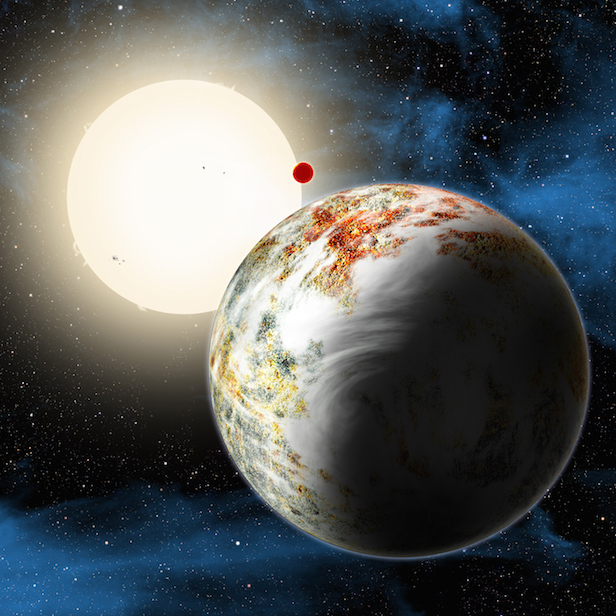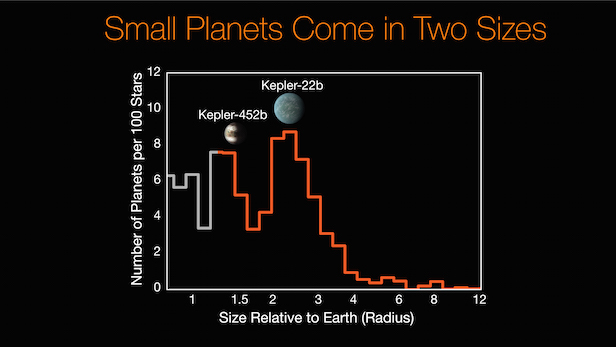Astronomers try to unravel the mystery behind super-Earths
Observations of the GJ 9827 system contain three exoplanets that could be super-Earths or mini-Neptunes

Super-Earths are usual defined by their mass, which is normally between 15 and 17 Earth masses. Image credit: CfA/D. Aguilar
Super-Earths are an interesting subsection of exoplanets, which still isn’t fully understood by many astronomers. In particularly, they fail to understand the environmental conditions required in order to produce these exoplanets that are larger than Earth, but smaller than Neptune. Researchers at the Carnegie Institute for Science have attempted to solve this riddle by studying the star system GJ 9827, which lies 100 light years away in the constellation of Pisces. This system contains three exoplanets slightly larger than Earth, one of which may be the most massive and densest super-Earths ever detected.
NASA’s exoplanet-hunting mission Kepler/K2 mission revealed a triplet of exoplanets, slightly larger than Earth, orbiting the star GJ 9827. Exoplanets this size appear to be the most common throughout the galaxy according to Kepler data, and their orbital periods range from a few days to several hundreds of days. If they are so common though, why do we not have any present in our Solar System? This is a question that has peaked researcher’s curiosities, as they investigate the conditions necessary for these types of planets to form and evolve.
One of the most fundamental aspects astronomers must investigate, in order to understand a planet’s history, is its composition. Researchers must differentiate between if a rocky super-Earth, like our own, or do they have solid cores with a large, gaseous atmosphere surrounding it.
In order to do so, scientists must be able to determine the planet’s mass and radius to a high degree of certainty. From this, the density of the planet can be calculated, and this allows scientists to make a more accurate estimation of a planet’s composition.
There has been a trend emerging from such analysis. Astronomers have noticed that planets with a radius 1.7 times that of Earth’s tend to have a gassy envelope, similar to Neptune. Whereas, a planet with a radius less than 1.7 times that of Earth’s, normally means the planet are rocky, like our home planet.
Researchers propose that this difference is down to a process called ‘photoevaporation’. This process strips the planet’s surrounding atmosphere of its volatiles, which are substances with a low boiling point such as water and carbon dioxide. When the volatiles are gone, this causes the planet to be much smaller, but more information is needed in order to prove this theory.

The most common exoplanet type within the W. M. Keck Observatory and NASA’s Kepler mission is the mini-Neptune, but there is a clear gap between mini-Neptunes and super-Earths. Image credit: NASA/Ames/CalTech/Uni. Of Hawaii/B.J. Fulton
This is why the planets orbiting GJ 9827 are important, as they contain planets above and below this 1.7 Earth radius cut-off. Planet b has a radius that is 1.64 times Earth’s, planet c has a radius that is 1.29 times Earth’s and planet d has a radius that is 2.08 times Earth’s. The Carnegie scientists have used their Planet Finding Spectrograph (PFS), attached to the Magellan Clay Telescopes at the Las Campanas Observatory, to calculate the important mass constraints.
“Usually, if a transiting planet is detected, it takes months if not a year or more to gather enough observations to measure its mass,” explains Johanna Teske of the Carnegie Institute for Science. “Because GJ 9827 is a bright star, we happened to have it in the catalogue of stars that Carnegie astronomers been monitoring for planets since 2010. This was unique to PFS.”
The results from the PFS indicate that planet b is roughly eight times the mass of Earth, making it one of the most massive and dense super-Earths ever discovered. The masses for planet c and d were estimated to be two and a half and four times the mass of the Earth respectively. Unfortunately, the uncertainty is very large for planets c and d, so a definitive answer cannot be given.
The information that has been gathered about planet d suggests it has an envelope containing many volatiles. This leaves a question mark over planet c, as researchers cannot deduce whether it has a volatile envelope as well, or not. The more in depth research on planet b also estimates that it consists of around 50 percent iron.
“More observations are needed to pin down the compositions of these three planets,” says Sharon Wang, also of the Carnegie Institute for Science. “But they do seem like some of the best candidates to test our ideas about how super-Earths form and evolve, potentially using NASA’s upcoming James Webb Space Telescope.”
Keep up to date with the latest reviews in All About Space – available every month for just £4.99. Alternatively you can subscribe here for a fraction of the price!




